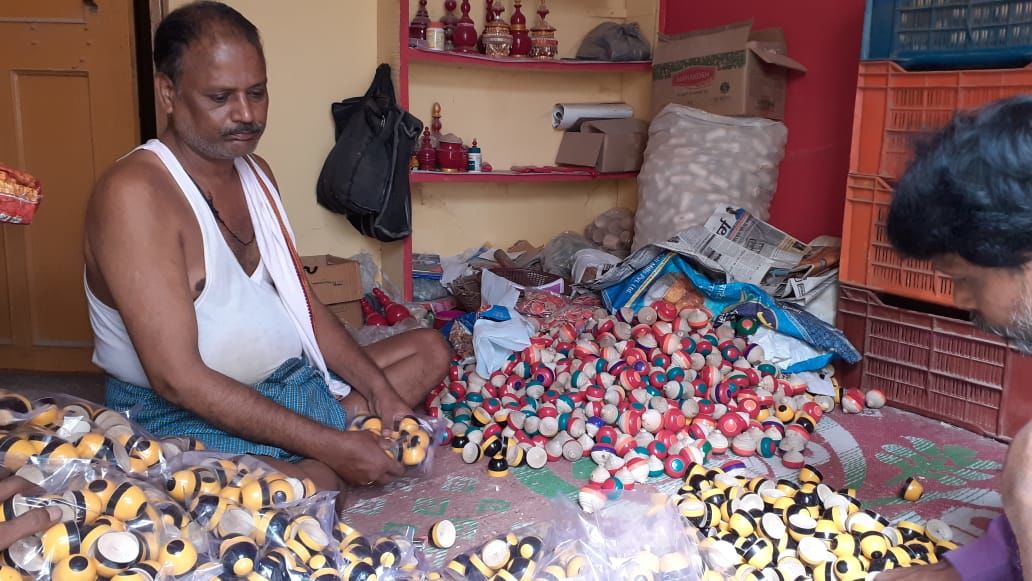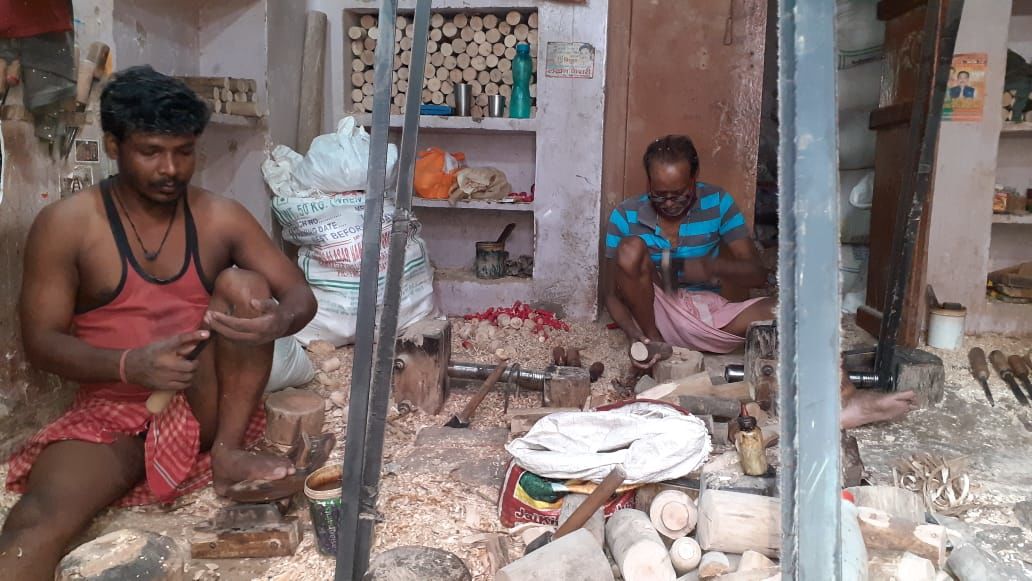The Toymakers of Varanasi: Crushed by COVID-19 and Chinese imports
Artisans in Uttar Pradesh’s Varanasi, which used to be very popular on the tourist and pilgrimage circuit, find themselves without buyers and struggle to feed their families.


Varanasi’s famed wooden craft tradition, which is at least two centuries old, is known both for its beauty and ability to stay contemporary. The artisans in Uttar Pradesh continue to make traditional wooden toys using the relatively expensive forest wood Koraiya, but they’ve also progressed to newer interpretations of their craft. Think hand-painted wooden pencils with a motif on top, door hangings with colourful wooden birds and butterflies. The artisans have managed to turn most problems into an opportunity and keep their craft alive.
The novel coronavirus disease (COVID-19) has dulled that optimism to a great extent. This city, also called Banaras or Kashi, is Indian Prime Minister Narendra Modi’s constituency and, under normal circumstances, hugely popular among tourists, because it is considered a holy place to visit. Since March, a huge chunk of potential buyers — tourists — have kept away. The shopkeepers refer to a buyer as mahajan, a great person.
The artisans tried their best to stay afloat, but are struggling. They are currently borrowing money from others to feed their families. The toys industry already faces stiff competition from inexpensive Chinese imports, and the pandemic has hit the artisans hard.
On August 30, Modi appealed to the citizens of the country to patronise indigenous toys to make India self-reliant. He also spoke of the need to better the toys’ market in Varanasi. Things, however, are bleak at the ground level.
Incidentally, in February, the India government proposed raising the import duty on toys from 20 per cent to 60 per cent, hoping it would support local manufacturing. However, more than one lakh retailers in the country protested the move and even went on a strike.

About 3,000 artisans create wooden toys in Varanasi’s Kashmiriganj and Khojwan areas. They make toys, sindoordaans (containers to store vermillion in), bangle cases and flower vases, besides other decorative items for households. The flower pots made at Lahartara in Varanasi are sought after across the country and abroad.
The wood craft business here, estimated at Rs 30 crore, is in dire straits now. The workshops are closed, and one cannot hear the sound of wood being shaped, scraped, and buffed or the strong scent of paint in the air. The craftspersons are starving.
Forty-five-year-old Shyam Gupta of Kasmiriganj has been making wooden toys since he was 10 years old. “It is getting increasingly difficult to keep afloat. Business has come to a standstill. The festive season (Dussehra, Diwali, Chhath) is upon us, but no mahajan has been coming to buy toys,” he told Gaon Connection. Because of the economic crises arising out of the lockdown, Shyam now works on adhiya, or half wage system. “These days, my wages range between hundred and two-hundred rupees. If you work independently, you can hope to receive a wage of three-hundred rupees a day, but if you work on adhiya, you work for four-hundred rupees and get only two-hundred,” he added.
What has most artisans worried is the fear of running their families. “It looks like the lockdown will be the death of us. Our income has reduced drastically, no traders visit us and I dread how I will look after my family,” rued Parmanand Singh, a 56-year-old toy maker.
Before the lockdown, he made toys during the day and sold them to traders in the evening, earning enough for his family. Now, he makes toys but there is no one to sell them too. He barely earns between Rs 200 and Rs 250 a day. He recently received an order for toys after months, and said his situation was better compared to that of his colleagues.
One thing craftsman Kishan Singh Parihar, who has been making toys for a quarter of a century, is particular about is educating his children, so that they enjoy a better quality of life. Before the lockdown, he earned about Rs 400 a day. Now, that has been halved. “With meagre earnings, how will I educate my children? They will also end up struggling like me to make ends meet. We don’t even get good wood now; it is moist and difficult to work with. Our toys’ industry is on the verge of being wiped out.” He showed Gaon Connection the range of toys he makes — Helen doll, Santhal figurines, jester, pots, vases, Shivling, mantap.

Lack of government support
The Uttar Pradesh government launched a labour maintenance scheme, Shramik Bharan Poshan Yojna, on March 24 to help daily wagers and workers affected by the lockdown with Rs 1,000 each for three months so that hunger was kept at bay. It was said that the amount was transferred to about 1.9 million workers for April and May through direct benefit transfer. On June 13, the third instalment was released to more than a million accounts. “Not a single paisa has reached our account though the women received five-hundred rupees a month in their Jan Dhan account,” alleged Shyam Gupta.
Parmanand Singh also denied receiving any aid from the government. “Everyone making toys already filled and deposited the fifty-one rupees form but no money has come to anyone’s bank account,” he said. Other craftsmen in Khojwan and Kashmiriganj had the same complaint.
Struggle to feed the family
Parmanand Singh has been making toys for four decades. “I am too old to look for some other occupation. I have only made toys all my life. I cannot pull a rickshaw or cart now. I don’t see any future. I keep borrowing so my family can eat. My income is stagnant and negligible; my debts are towering,” said Singh.
Parihar is a resident of Padav in Varanasi. He pedals a distance of over 26 km every day to come to Khojwan for work and return. His children are also impacted by the digital divide — he cannot buy the necessary equipment to help his children attend online classes. His options are difficult but the choice is clear — food over education.

Adverse effects of Chinese toy imports
The proliferation of Chinese toys has seen the local toy makers reduce their portfolio. “The business is sinking every day,” said Parihar. “We have discontinued about 400 models. Their toys are primarily in plastic and machine-made, and so less expensive. They look very attractive, and customers end up buying them. Our input costs are high, we make them by hand. All that adds to the cost. Wooden toys are of great quality, but because they are perceived as expensive, the demand is dwindling,” he added.
Parihar’s fear is not without reason. China has a lion’s share of close to 80 per cent in the Indian toys market. According to the Toy Association of India, toys worth Rs 4,000 crore are imported from China annually; the retail value of the Indian toy industry is around Rs 16,000 crore. It is said that 75 per cent of the raw material needed to make toys is also imported from China.
These toymakers would like nothing better than to pass on their craft to their children, but Parihar said their struggles discourage them from passing on the craft to their children. “This art will die with our generation,” he said.
The craftspeople’s demands are limited. They would like their age-old craft to be better branded and marketed. They also demand that the government subsidises machinery used to make toys so that they can scale up without pain. Currently, India’s share of the global toy market of 7 lakh crore is negligible, Modi said in his address.
Whether the Prime Minister’s call for supporting local toymakers helps or not is yet to be ascertained. But, it has provided hope to toymakers who have been left dejected. Parihar said the Prime Minister’s appeal to new entrepreneurs to invest in the toys market of Varanasi might give the industry a fresh shot at life. “Our forefathers have told us this craft does not promise a good life. They were right,” said Parihar.
Can toy makers survive if they increase prices, even by a little? “Not possible,” said Bablu Gupta, a toy manufacturer. “Even if we want to increase it by five rupees a toy, the mahajan stops buying goods,” he added.
Only a miracle can now help these craftspeople chisel better lives for their families.
Anand Kumar is an intern with Gaon Connection.

